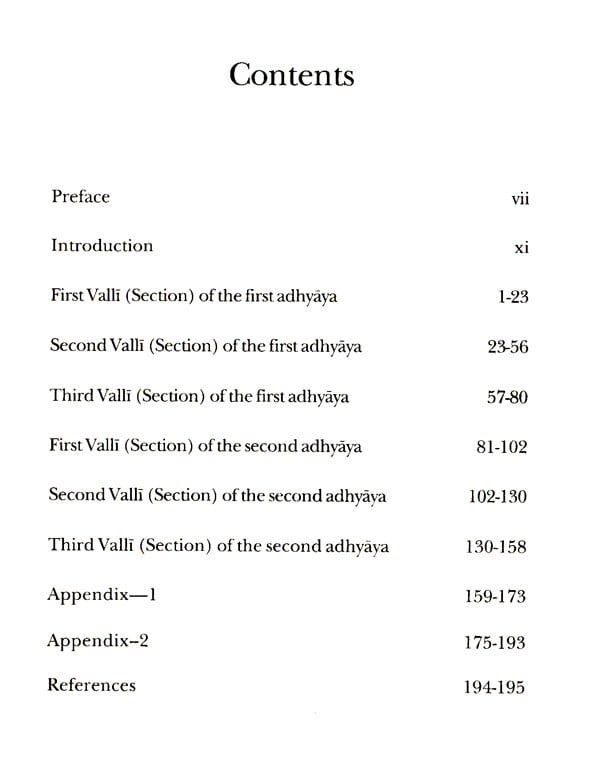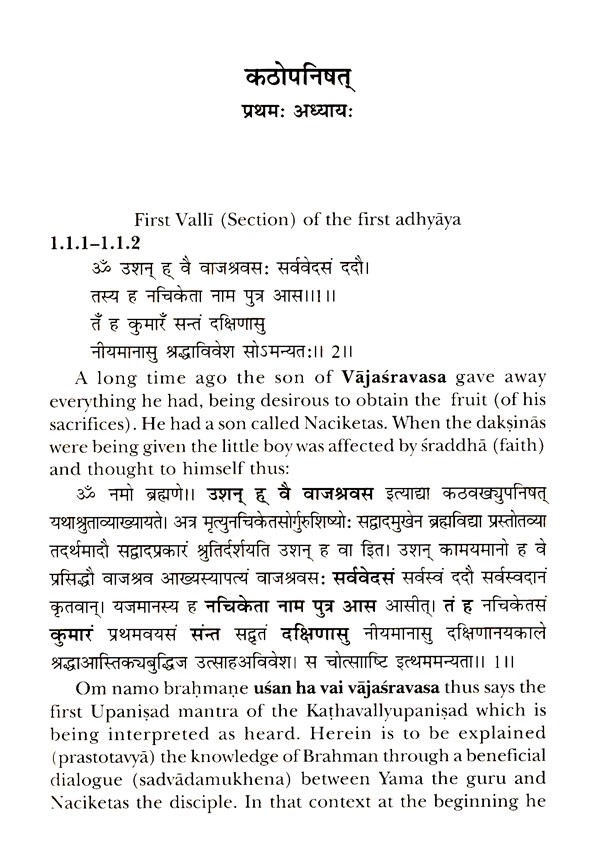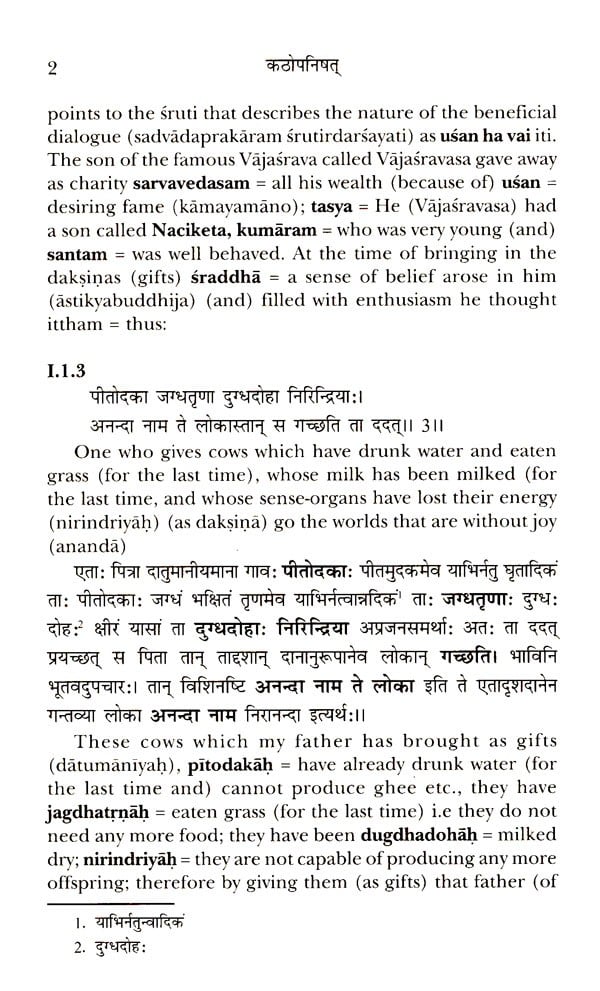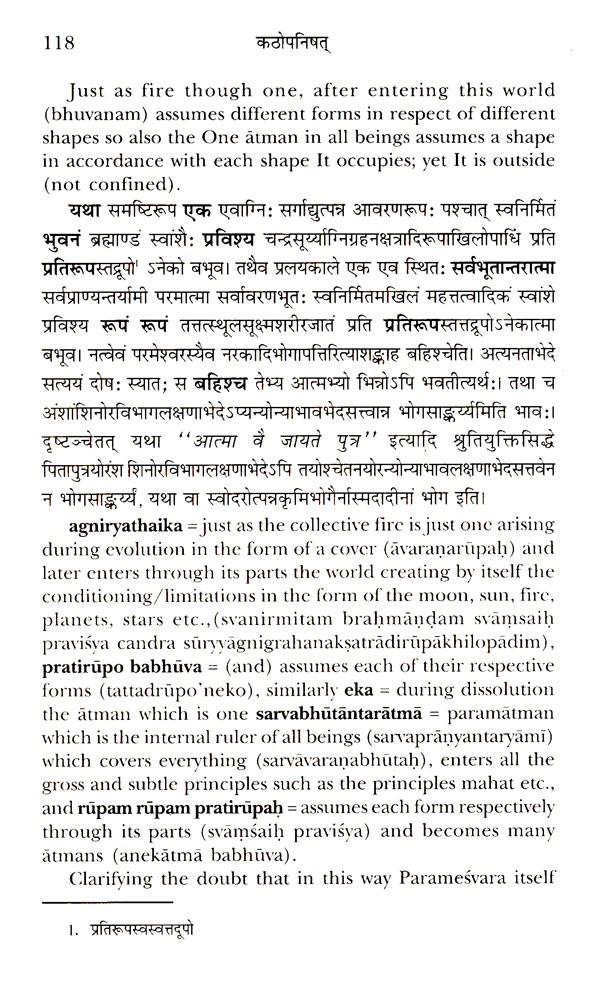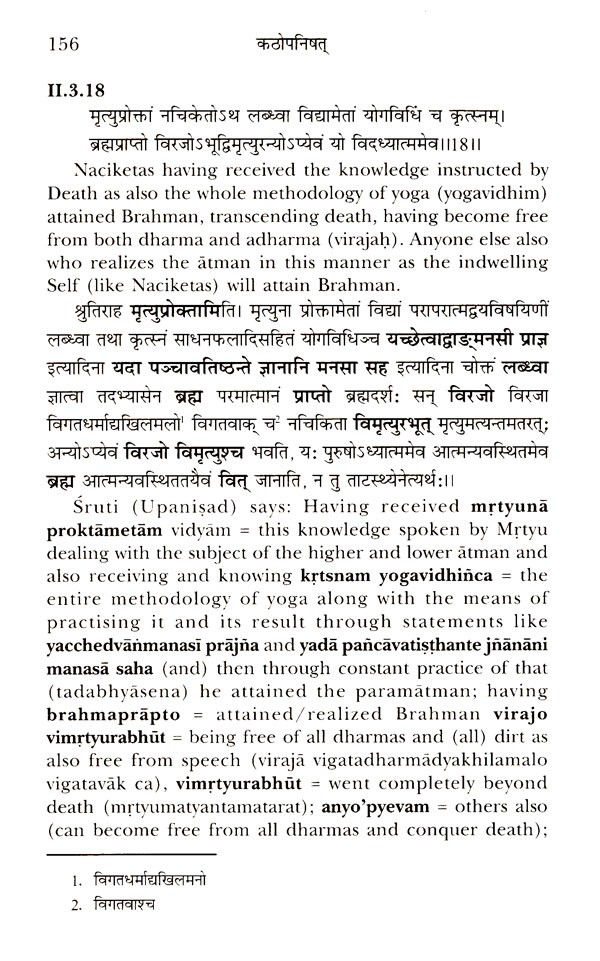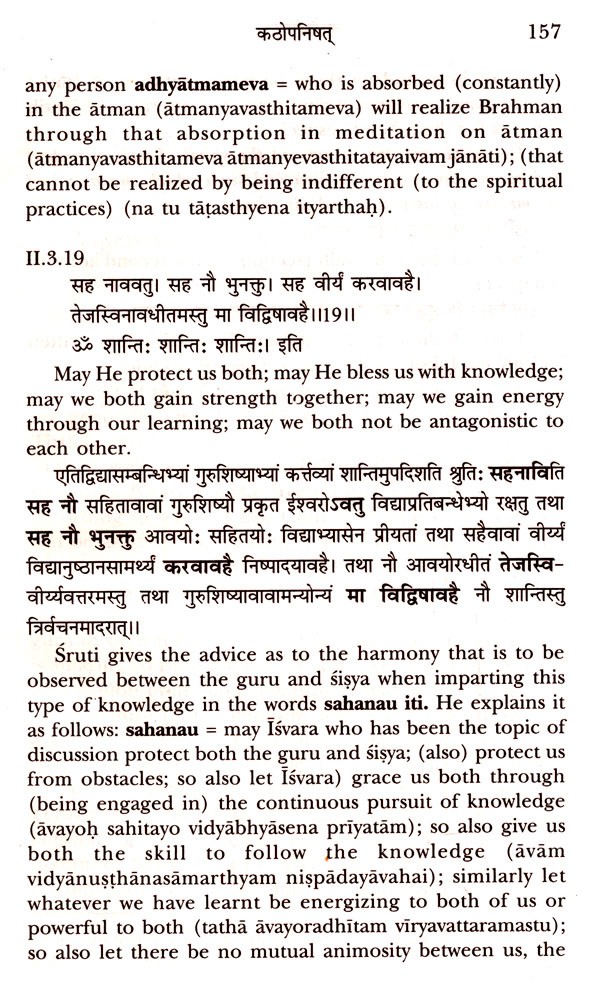
Kathopanisat (With the Commentary of Vijnanabhiksu Called Vedantaloka)
Book Specification
| Item Code: | AZB135 |
| Author: | T.S. Rukmani |
| Publisher: | MUNSHIRAM MANOHARLAL PUBLISHERS PVT LTD |
| Language: | Sanskrit Text With English Translation |
| Edition: | 2018 |
| ISBN: | 9788121513227 |
| Pages: | 228 |
| Cover: | HARDCOVER |
| Other Details | 8.80 x 5.80 inches |
| Weight | 372 gm |
Book Description
Amongst the eighteen works ascribed to Vijñānabhikṣu in all available catalogues are commentaries on a group of eight Upanişads collectively known as Vedāntāloka. None of the commentaries on these eight Upanișads has so far been available to the scholarly world. There is also no English translation of any of these Vedāntāloka Upanișad commentaries as well. I have been searching for these commentaries since the completion of my Yogavārttika work in 1989. Eventually after a strenuous search, by a stroke of luck some of the commentaries of these Vedāntāloka Upanișads were traced to the Asiatic Society in Calcutta but they were all in a medieval Bengali script. However after much effort the Kathavallyāloka commentary on the Kathopanişad was transcribed into Devanāgarī by Ms Chatterjee who knew both medieval Bengali as well as Sanskrit. The manuscript had a number of errors and the scribe had added notes on the sides as well and had to be edited carefully before translating it. But the satisfying part is that for the very first time a Vedāntāloka commentary of Vijñānabhikṣu is seeing the light of day. Read along with Bhikṣu's other commentaries on Yoga, Vedānta and Samkhya this work will throw a great deal of light on the commitment of Bhikṣu to his pet Yoga philosophy.
T. S. Rukmani has had a distinguished academic record and has been teaching and researching mainly in the areas of Hinduism, Advaita Vedanta and Sankhya-Yoga for the last seventy years. She joined the Department of Religion, Concordia University, Montreal, Canada, as Professor and Chair in Hindu Studies in 1996 and retired from that post in July 2012. She was the first Chair for Hindu Studies and Indian Philosophy at University of Durban Westville, Durban, South Africa.
In 1972, she was awarded the Ida Smedley International Fellowship to work as a post-doctoral fellow on comparative philosophy, under the guidance of the world-renowned philosopher, the late Prof. B. K. Matilal, at Toronto University. She has won many awards in India and abroad. Her four volume work on Vijñānabhikṣu's Yogavarttika and her two volume work on Sankara's Yogasutrabhasyavivarana have been widely acclaimed in scholarly circles as significant contributions to the furtherance of Yoga Philosophy. She has also written and edited seven other books dealing with different aspects of religion and philosophy. She has also published many research papers in academic journals, both in India and in other parts of the world.
TETŐ Vijñānabhikṣu (Bhikṣu) is considered to have lived in the latter half of the sixteenth century of the common era when bhakti was at its peak in Indian religious history. Bhikṣu calls his brand of advaita as avibhāga-advaita-Vedānta which he advocates in all his works and especially in his Vijñānāmộtabhāșyam. This brand of avibhāga-Vedānta accommodates Isvara and Iśvarapranidhāna which is a special kind of devotion towards Iśvara, as means to mokșa/kaivalya, even when it accords the highest status to knowledge (jñāna) for liberation (moksa/kaivalya/apavarga). His two types of kaivalya as realizing the jīvatattva and Brahmatattva, as well as his commitment to Samkhya-Yoga both in its metaphysical and soteriological aspects, his unique interpretation of vikalpa, his use of the device of karmakartřvirodha and many more such innovations has earned for him a respectable position in the philosophical tradition of Sanskrit scholarship.
Having dealt with Bhikṣu's Yogavārttika in great detail in four volumes in my annotated English translation (198189) I was still searching for Bhikṣu's unpublished manuscripts. I got to know of the availability of the Vedāntāloka Upanișadic commentaries in the Asiatic Society Library, Calcutta. I was able to get some four or five of these Vedāntāloka commentaries in the Asiatic Society Library, Calcutta but unfortunately, when I received them was pleasantly surprised to discover that they were in the Bengali script and that too in the medieval/old Bengali script. Finding a person to transcribe them was a herculean task but finally Ms Sumita Chatterjee who could read both Bengali (including medieval Bengali and Gaudi with difficulty) as well as Devanāgarī agreed to do the transcription. I am grateful to her for undertaking this task.
Since I had decided to edit and then translate these manuscripts into English with annotations I decided to start with the Kathopanişad which is one of the popular Upanisad texts. The transcribed manuscript luckily was complete; however it had a number of mistakes and numerous editorial changes had to be made. I decided to read the manuscript with a vaiyākaraṇa scholar (grammarian) as it is always better to read a manuscript along with another scholar in order to reach the best possible option for errors in the manuscript. This is especially so when there is only one manuscript of the work available as in this case, with no second one to compare it to. Dr Tilak Rao from Veda Vidyā Gurukulam in Bangalore, a well known vaiyākaraṇa,was ready to read the manuscript with me and between the two of us we corrected some of the glaring mistakes in the body of the manuscript. I am grateful to Dr Tilak for his cooperation in this matter.
The commentary itself is not very long but the importance of this present work offered to the scholars is that it is for the very first time that a commentary of Vijñānabhikṣu on an Upanişad is being edited and published with an annotated English translation. The shortcomings of the manuscript as well as a detailed analysis of the contents regarding the manuscript is given in the Introduction to this work itself.
Vijñānabhikṣu (Bhiksu hereafter) is known as a Vedāntācārya in the tradition. He is considered to have lived in the second half of the sixteeth century (see Rukmani 1981: Introduction). He has written commentaries on the Brahmasūtra, the Iśvaragītā from the Kūrma Purāṇa and on some Upanișads collectively known as Vedāntāloka. Almost all catalogues of Samskrita works mention Bhikṣu as the author of a set of Upanişadic commentaries known collectively as Vedāntāloka. The accepted eight Upanişads that figure under this category of Vedāntāloka are the Kathavallyupanișadālokaḥ, Kaivallyopanișadālokaḥ, Maitreyyupanișadālokaḥ, Māņdūkyopanișadālokaḥ, Mundakopanişadālokaḥ, Praśnopanişadālokaḥ. Taittiriyopanişadālokaḥ and the Svetāśvataropanişadālokaḥ. The Bșhadāraṇyakopanişadālokaḥ does not figure under this list. However, Noriaki Hosoda reported in the Journal of Indian and Buddhist Studies Vol 46, No 2, March 1998 that he found two incomplete manuscripts called Bșhadāraṇyakavyākhyā by Bhikṣu in Nāgarī script in the Calcutta Sanskrit College library. Both the commentaries declare that they cover upto the second Brāhmaṇa of the fourth adhyāya based on the Kāņva-śākhā; but according to Hosoda, in effect they only cover upto the second Brāhmaṇa of the second adhyāya.
Since only eight Upanișadālokas are mentioned in the catalogues available and nowhere is the word 'vyākhyā' used for the āloka commentaries, more evidence needs to be forthcoming to attribute this work to Bhikṣu. The reason that Hosoda attributes this work to Bhikṣu is due to the statement “iti vijñānabhikṣukrte Vedāntāloke Bịhadāraṇyakasya tritīyādhyālokaḥ (at the end of the Br. i (SB. xvi. iii))”. In the same work Hosoda had stated as his objective the preparation of “... a romanized text of this [Bị. Up] and a survey of the remaining parts is necessary.” He also had stated that “the other eight commentaries should be published and examined not only for the Sāṁkhya or Vedānta-study but also for the Upanisad-study”. Since I have had no further information on this front I take it that so far Hosoda has not followed up with this project?.
**Contents and Sample Pages**
